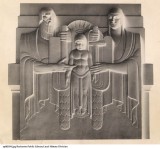SQUEEZER’S (1946-1955) and BAND BOX (1955-1959)
If you’ve attended the Rochester International Jazz Festival in the last few years, you are probably familiar with the name Squeezer’s. One of the festival’s venues has donned the moniker since 2014, but the original Squeezer’s dates back to the 1950s.

Squeezer’s Musical Bar ca. 1950s. From: Photo provided by Joseph Strazzeri Jr. to Democrat & Chronicle, June 22, 2014.
Joe “Squeezer” Strazzeri, a classically trained pianist, opened his eponymous venue at 420 State Street in 1950.

Squeezer’s stood at 420 State Street, north of Brown Street. From: City of Rochester Plat Map, 1935.
The compact club steadily drew a loyal clientele. Kodak employees came from across the street for lunches and dinners prepared by Joe’s wife Phyllis, while jazz aficionados packed the room in the evenings for nightly jam sessions.
One of the jam session’s early fixtures was organ and piano virtuoso, Doug Duke. Buenos Aires-born and Rochester-raised, Duke led Squeezer’s house band for a time and was initially the only paid musician in the joint.

From: Democrat & Chronicle, April 11, 1956.
Duke took pleasure in playing with both local beboppers and touring members of more commercial-sounding groups, who often dropped by Squeezer’s after their concerts.
“It’s relaxing for these guys to play loose, after playing all night with music [sheets] in front of them,” Duke informed the Democrat & Chronicle in 1950, “They like to come here after work for a big fat ball and knock themselves out. It’s a great thing for a guy who’s been playing with a Micky [corny] band to come here and pick up a little trash.”
The club witnessed its share of non-Micky jazzmen as well. Dizzy Gillespie, Stan Kenton, and Duke Ellington all reportedly graced the Squeezer’s stage before it ended its run in 1955.
The building carried on as a jazz club—called the Band Box—and continued to host talented artists including Terry Gibbs (vibraphone) and Art Blakey & the Jazz Messengers.

From: Democrat & Chronicle, March 16, 1955.
On Easter Sunday 1956, a particularly stellar quintet comprising Clifford Brown (trumpet), Max Roach (drums), Sonny Rollins (sax), Richie Powell (piano), and George Morrow (bass), wowed an audience of about 12 people. Among the lucky dozen were Gap and Chuck Mangione. Gap later recalled feeling immensely grateful for having been able to see the show as Brown and Powell died in a car crash less than three months after the performance.
The Band Box suffered a tragedy of its own three years later. In the early morning hours of March 10, 1959, a set of fires coursed through the building, putting an end to the once storied jazz venue.

The former site of Squeezer’s/Band Box on State Street. From: Googlemaps, 2019.
The next post in this series will explore two seminal jazz clubs of the Corn Hill neighborhood…
-Emily Morry

[…] to a number of jazz clubs, which were attended by many famous and influential jazz musicians. Squeezer’s (1946-1955) was one of Rochester’s earliest well-known clubs. Located in High Falls, the venue attracted many […]
[…] of Rochester. Previous installments detailed the history of renowned venues such as The Pythodd, Squeezer’s, the Cotton Club, and the Ridge Crest Inn. This week, we’ll explore the rise and fall of the […]
[…] most of the clubs in this series (see parts 1, 2, 3, 4, 5) had their heyday in the 1940s and 1950s, the following venue was something of a late […]